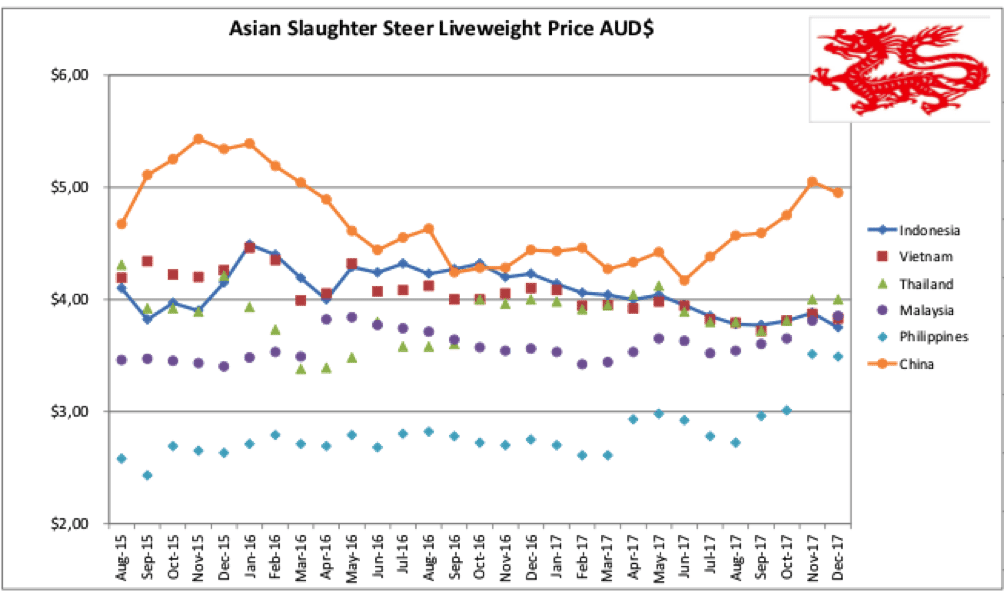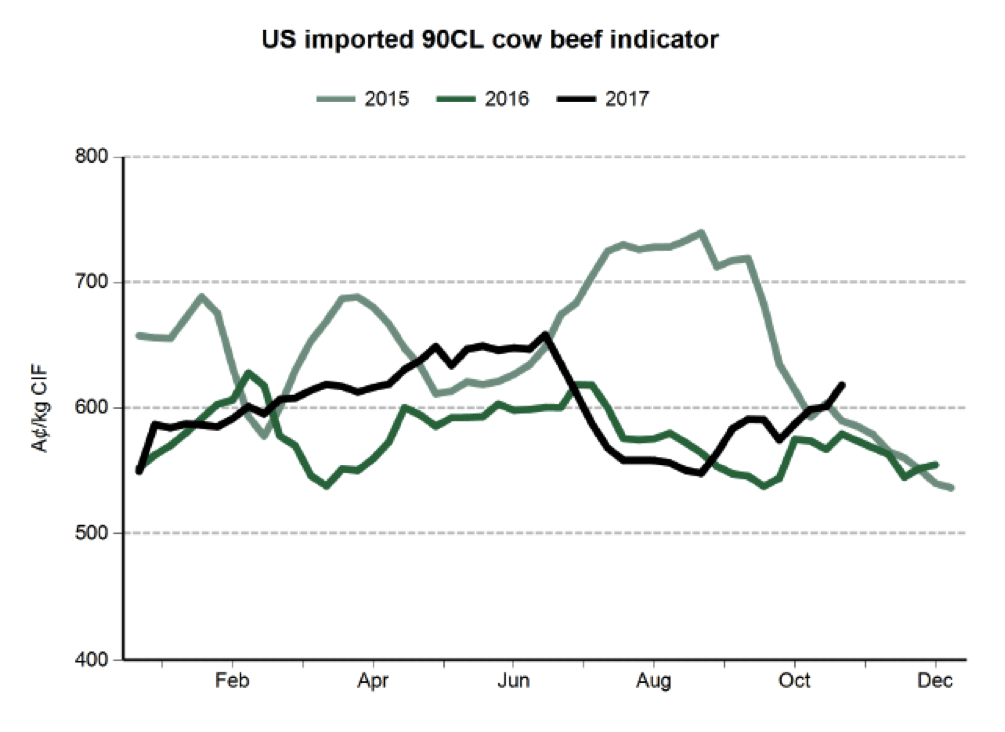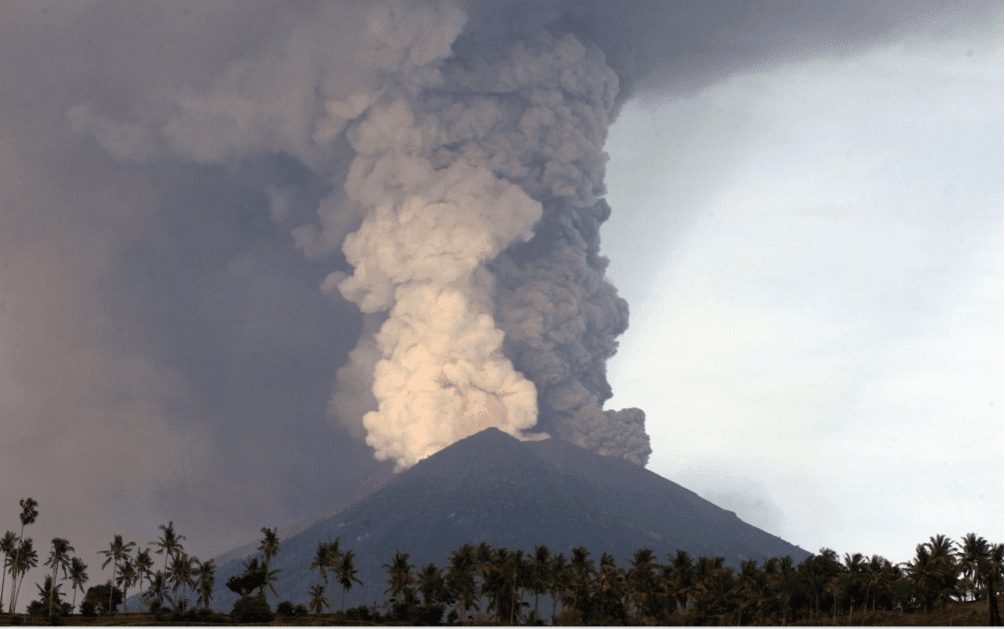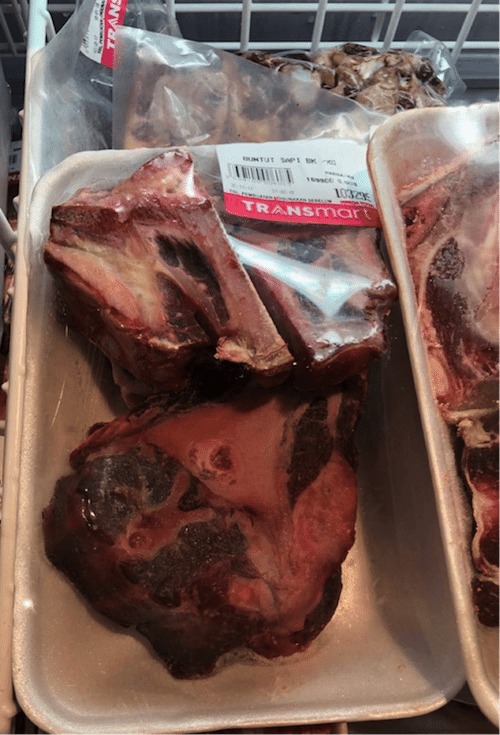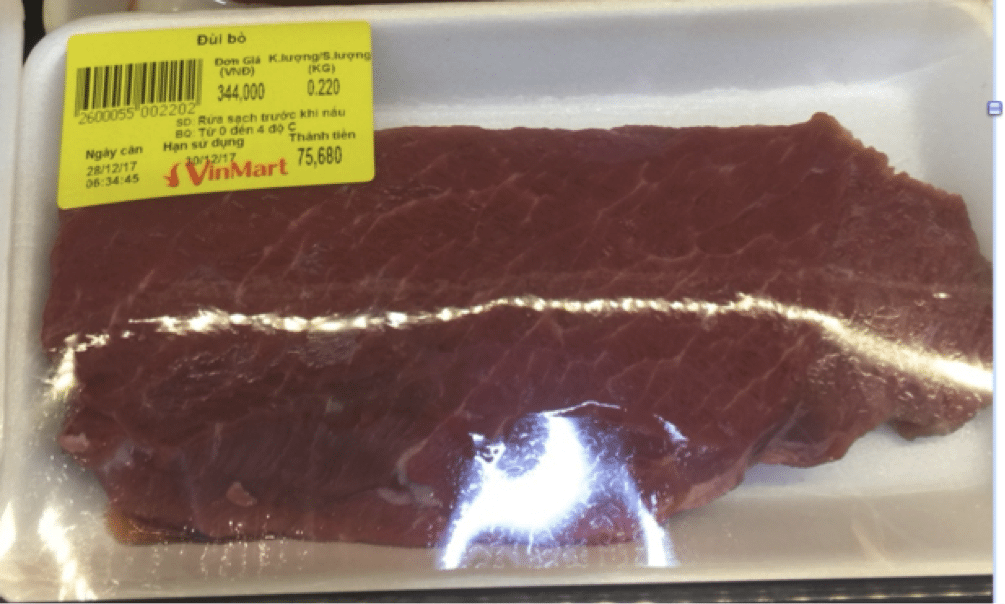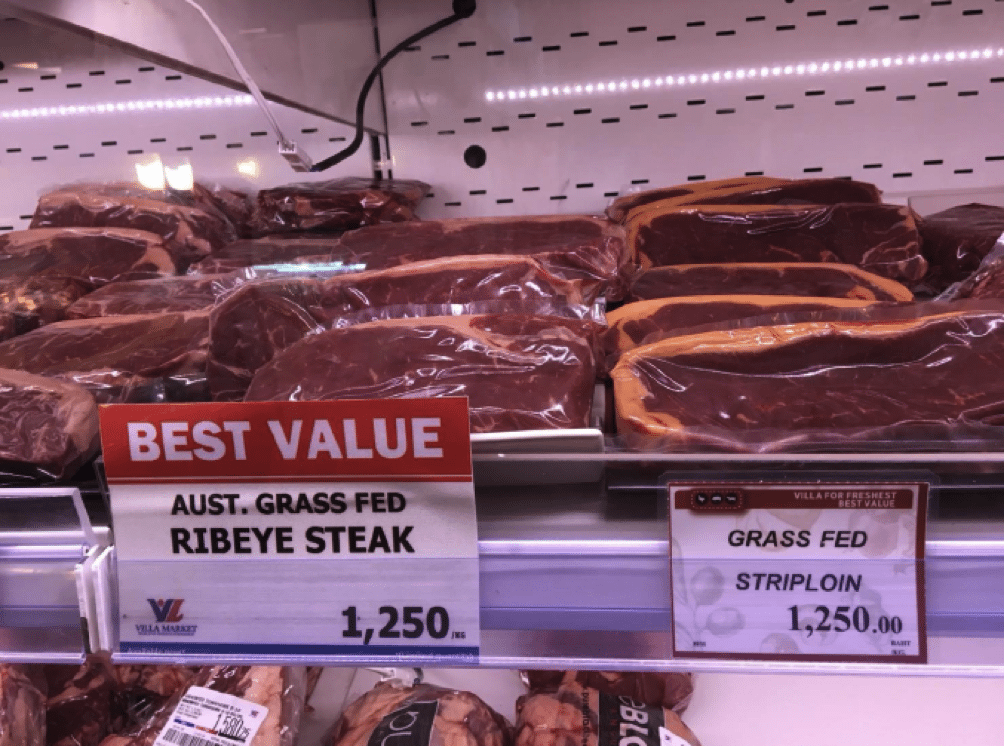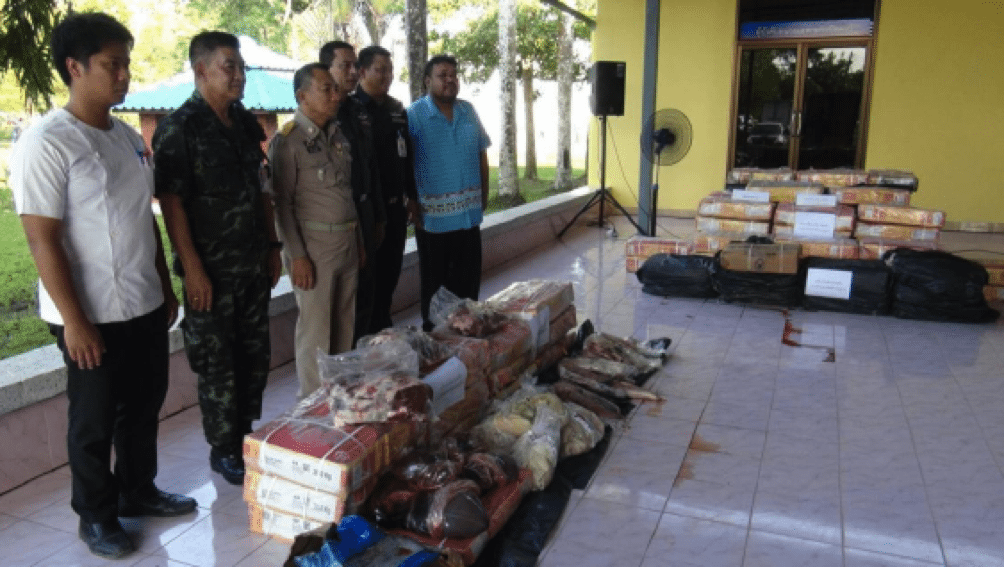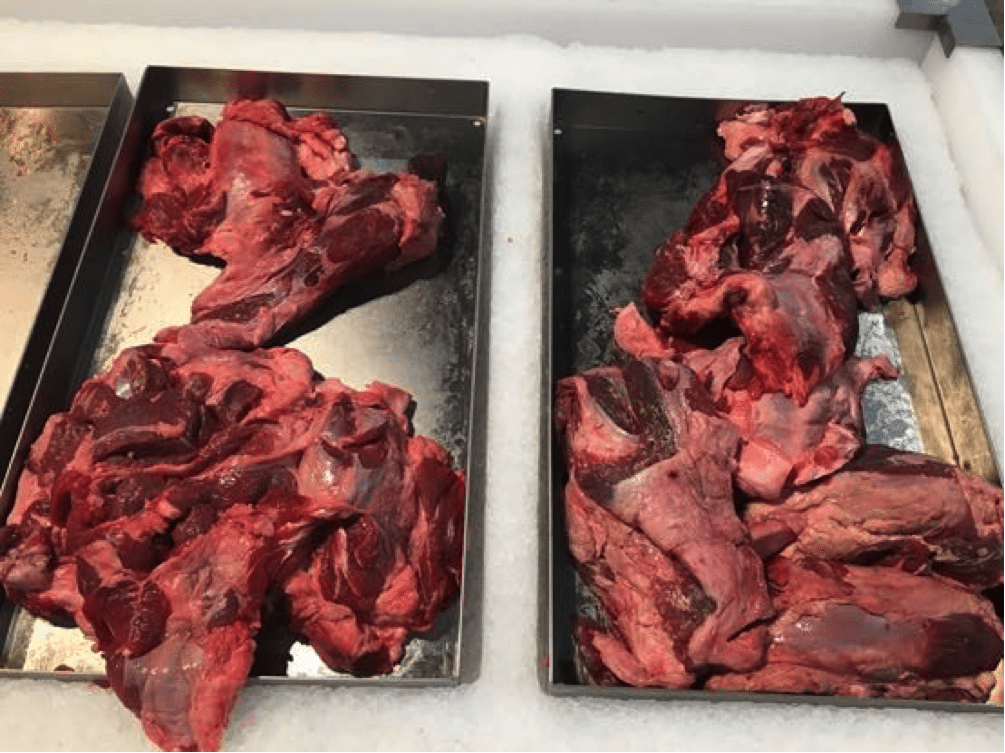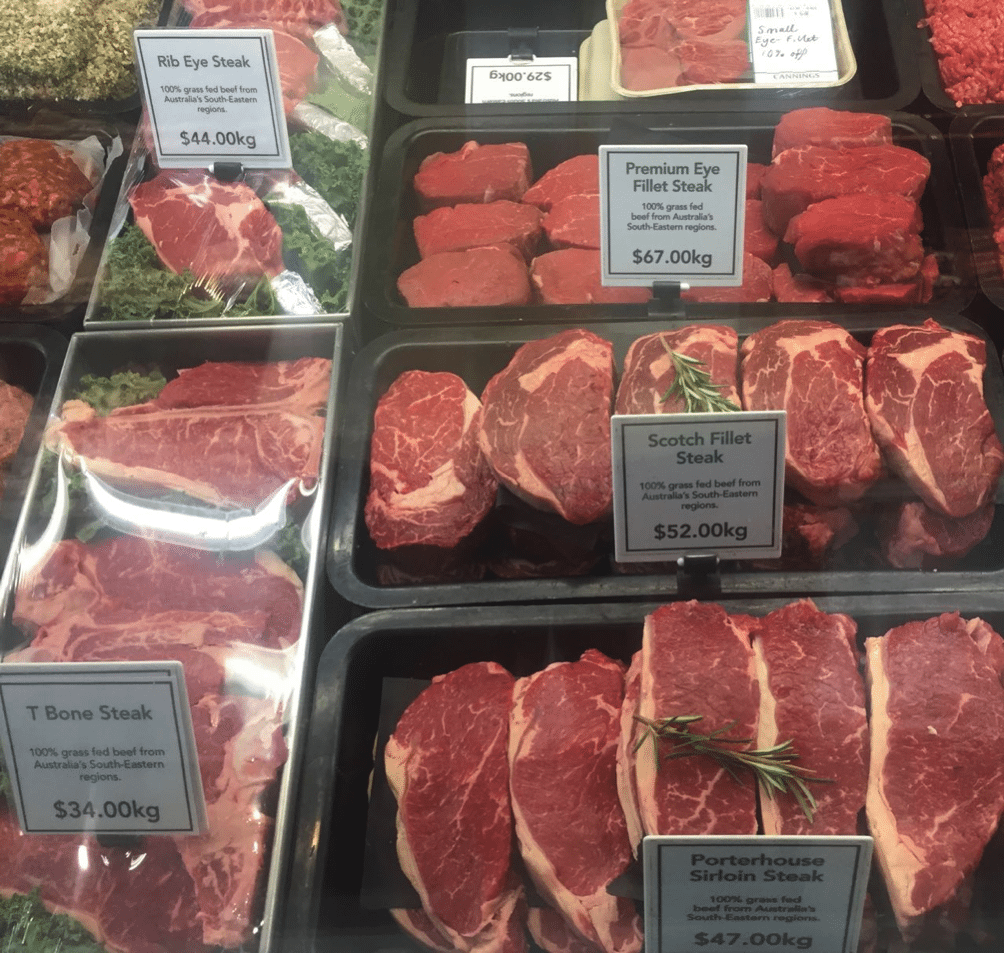(For Indonesian Bahasa language version of this report click here)
Indonesia: Slaughter Steers AUD $3.75 / kg live weight (Rp 10,400 = $1AUD)
When I asked one of my main sources from the Indonesian live cattle industry to describe the business environment for December his simple comment was “terrible”.
Demand remained weak with prices slipping even lower than November’s rates. While some fortunate sellers managed to achieve up to Rp41,500 during December, most sales were in the 38-41k range. I have dropped the indicator rate from Rp40k last month to Rp39k for this month’s graph.
The only positive note for December is that most importers have cleared out their backlog of overfat cattle through discounting, credit for the butchers and reduced imports so the pressure for discounts and credit will hopefully be easing in January.
Another milestone for the trade is a steady price for the northern Australian wet season sales, something not seen since the trade began (to Malaysia) almost 40 years ago. CIF feeder prices are holding at around AUD$3.95 per kg live weight landed Jakarta with almost total buyer resistance at any level above this price.
New permits issued for Indian buffalo beef imports in 2018
Last month I reported that the Ministry of Agriculture announced that “they had ‘decided to not issue any new recommendation letters for future Indian beef imports. The Director General of Livestock Services advised that the new policy was because the importation of “buffalo meat has not been successful in stabilizing the price of beef in Indonesia and that the Ministry would like to increase Indonesia’s beef production.”
On the 7th of December, Bisnis.com reported that the government “coordination meeting” announced that new import permits for 2018 would be issued for 31,000 tons of frozen Indian buffalo, which represents the unutilized allocation from the original 2017 permits (which have now expired). The coordination meeting includes representatives from the Ministry of Agriculture together with the Commission for the Supervision of Business Competition, Perum Bulog and the Food Satgas (taskforce).
The government reported that a total of 55,000 tons of frozen Indian buffalo was imported during 2017 with 18,528 tons still in Bulog cold stores as at 7th December 2017 suggesting that the actual consumption of officially imported Indian buffalo for 2017 was 36,472 tons. The official line is that Indian beef will be selling for around Rp65,000 wholesale with retail prices in the order of Rp75,000 – 80,000 per kg.
Indian buffalo meat selling at similar prices to imported Aus beef – so why take the disease risk?
But there seems to be a serious flaw in the logic here.
The reason for accepting the Foot and Mouth Disease (FMD) risk of importing Buffalo from India was because the price was so low that it would help reduce the beef prices in the domestic market.
This has not happened as most of the Indian buffalo product has been utilized by the bakso ball manufacturers and the low-end restaurant trade with the entire margin retained by the traders while prices of the end product to Indonesian consumers have remained constant. i.e. Total failure.
The irony is that frozen Australian beef from lesser cuts and lower priced animals such as cull cows can be delivered to Indonesia at a very similar price to the Indian product, so why take the risk of disease transmission?
There is little doubt that the Australian product is of a much higher standard in terms of food safety, chemical freedom, meat quality, taste and wholesomeness. So why not avoid the risk of FMD transmission and buy a better quality product from Australia at about the same price as the Indian buffalo?
The prices below show the different grades and prices of Australian beef CIF (Cost, Insurance and Freight) delivered to the United States. CC/CF is Cutter/Canner Cow Forequarter which has a delivered price reported for November 2017 of about AUD$5.50 per kg. Forequarter Indian Buffalo trimmings were selling last week in the Bogor wet markets for Rp75,000 or about AUD$7.10 per kg (AUD$1 = Rp10,550). If we assume that the traders would need to add a margin of say 30% for the Australian product then the wet market price could be somewhere in the range of AUD $7.15 or Rp75,430 per kg.
Source : Steiner Consulting Group.
The graph below is sourced from MLA market report of November 21, 2017 and shows the movement in cow beef prices for the last 3 years.
So if the price of disease free, high quality frozen Aussie beef trim is about the same price as frozen Indian buffalo with its inherent disease risk then why take the risk?
Yes, it is a good policy to have a wide range of market alternatives to avoid the danger of a single market either forcing prices up or closing down altogether for some unexpected reason but to achieve this by risking the introduction of FMD doesn’t seem to be a sensible trade off.
Bali is a major buyer of high quality Aussie beef to satisfy their hungry tourist trade so the disruption to tourist arrivals during December from the recent eruptions of Mt Agung has had a devastating effect on demand with some suppliers advising a drop in December sales of up to 90%. Some large hotels actually had several days of zero occupancy. The volcano poses no risk to the main tourist area as it is too far away but the real problem is that if the prevailing winds blow the ash towards the airport then flights are cancelled and many travellers just don’t want to take the chance of getting caught so they decide to have their holiday somewhere else. My advice is to come and take your chances because Bali is one of the best places anywhere to be forced to stay a bit longer than planned!
Photo from the internet: Mt Agung during December, about 80km from Denpasar.
A friend was visiting a large supermarket in Jakarta recently and was “attracted” to the beef section by a terrible smell. The product in the photo below was quite rotten and raises the question of quality control for high-end beef retail in some of the largest and most popular supermarket chains in Indonesia. While this particular example of stinking product is certainly a rare event, the general standard of hygiene and quality control in most supermarkets could use a serious upgrade.
Vietnam: Slaughter Steers AUD $3.83/kg (VND17,500 to $1AUD)
Prices remain static across the market with Dong67,000 per kg still the indicator price for slaughter steers in Ho Chi Minh City. Bulls in the south can make up to D72,000 because leaner carcases are preferred. Fat heifers up to 500kg are discounted to around Dong61,000 due to their high % of fat.
Feedlot capacity across the country is about 100,000 head with current stocks estimated at around 70%. This relatively high level of inventory is a reflection of importers getting prepared for the peak demand period of the Tet lunar holiday festival which occurs this year on the 16th of February (the year of the Dog). Tet is short for Tet Nguyen Dan which is Vietnamese for the “Feast of the First Morning of the First Day.” The festival welcomes the beginning of spring.
Prices in the wet and supermarkets also remained constant during December.
“Dui bo” is Vietnamese for Knuckle: selling at a supermarket in Ho Chi Minh City for Dong344,000/kg or AUD$19.65. Is there any wonder that demand is weak! I can buy top quality Rib Eye in Indonesia for this price.
The pricing above is further proof, if any is needed, that there is obviously no scope for higher prices in the Vietnamese retail market and therefore nil chance of forcing prices of imported Australian cattle up from current levels.
Thailand: Slaughter Steers AUD $4.00/kg (Baht 25.0 to $1AUD)
The Thai market remains in a difficult place with generally poor margins and lack-lustre demand. The best market segment is specialist beef supplies of high quality product from Australian cattle fattened locally. These fat steers can attract prices as high is Baht110 per kg while low quality local cattle destined for the wet market tables can only achieve Baht80 per kg live. Prices for cattle suitable for export to Vietnam are bringing about Baht100 per kg.
High quality imported Aussie grass fed beef is selling for AUD$50 in the top end supermarkets in Bangkok.
Thai police publicising a recent seizure of illegally imported frozen beef in southern Thailand. Not sure what the issue is here because it has been legal to import Indian beef into Thailand for many years.
Malaysia: Slaughter Steers AUD $3.85 per/kg (RM3.12 to $1 AUD)
Nothing to report here except a minor change in the exchange rate.
Philippines: Slaughter Cattle AUD $3.49/kg (Peso 38.7 to AUD$1)
Prices remain firm in the Philippines with the movement in the AUD rate only due to the exchange rate fluctuation. My Philippines agent reports more of the same across the country with a booming economy leading to strong spending across the board.
China: Slaughter Cattle AUD $4.95/kg (RMB 5.05 = AUD$1)
The continuous rise in prices of slaughter cattle have levelled off in Beijing (still Y25) while rates in Shanghai have moved up from Y24 to Y25 per kg live weight.
I am advised that another “trial” shipment of slaughter cattle from Australia to China will be departing soon. Let’s hope that this is further evidence that the commencement of proper commercial trade is not too far away.
Photo: low quality beef presented at a Beijing supermarket. Not surprising that this sells for a large discount over well presented quality product. The price of this product is around Y52 per kg (AUD$10.34) while good quality beef is achieving Y78.
Grass fed beef in a high end Melbourne butcher shop over Christmas. Looks magnificent but so are the prices!
Laos has recorded frosts for only the second time in its history with 2016 being the first. The article below is from the Vientiane Times on the 22nd of December 2017. Some livestock had difficulty getting a drink as they waited for the ice to melt on their water supplies.
Market price table for December 2017
(All prices converted to AUD)
These figures are converted to AUD$ from their respective currencies which are changing every day so the actual prices here are corrupted slightly by constant foreign exchange fluctuations. The AUD$ figures presented below should be regarded as reliable trends rather than exact individual prices. Where possible the meat cut used for pricing in the wet and supermarket is Knuckle / Round.
| Location | Date | Wet Market
AUD$/kg |
Super market
$/kg |
Broiler chicken
$/kg |
Live Steer
Slaughter Wt AUD$/kg |
| Indonesia | July 17 | 12.50 | 14.71 | 3.84 | 3.85 |
| Rp10,575 | August 17 | 12.29 | 14.47 | 3.50 | 3.78 |
| Rp10,600 | Sept 17 | 12.26 | 19.05 | 3.25 | 3.77 |
| Rp10,500 | October 17 | 12.57 | 19.23 | 3.33 | 3.81 |
| Rp10,300 | Nov 17 | 12.82 | 19.61 | 3.30 | 3.88 |
| Rp10,400 | Dec 17 | 12.98 | 14.42 | 3.75 | 3.75 |
| Philippines | July 17 | 7.85 | 8.10 | 3.54 | 2.78 |
| P40.5 | August 17 | 7.40 | 7.40 | 3.46 | 2.72 |
| P40.5 | Sept 17 | 7.41 | 7.53 | 3.28 | 2.96 |
| P39.9 | October 17 | 7.69 | 7.64 | 3.46 | 3.01 |
| P38.5 | Nov 17 | 8.05 | 7.92 | 2.99 | 3.51 |
| P38.7 | Dec 17 | 8.01 | 7.88 | 3.75 | 3.49 |
| Thailand | July 17 | 9.12 | 10.65 | 2.66 | 3.80 |
| THB 26.3 | August 17 | 9.12 | 10.65 | 2.66 | 3.80 |
| THB 26.3 | Sept 17 | 9.13 | 10.65 | 2.66 | 3.72 |
| THB 25.7 | October 17 | 9.34 | 10.89 | 2.72 | 3.81 |
| THB 25.0 | Nov 17 | 9.60 | 11.20 | 2.80 | 4.00 |
| THB 25.0 | Dec 17 | 9.60 | 11.20 | 2.80 | 4.00 |
| Malaysia | July 17 | 9.55 6.57 | 10.15 | 2.53 | 3.52 |
| MYR 3.39 | August 17 | 9.44 6.49 | 10.03 | 2.51 | 3.54 |
| MYR 3.33 | Sept 17 | 9.60 6.60 | 10.21 | 2.34 | 3.60 |
| MYR 3.28 | October 17 | 9.76 6.71 | 10.36 | 2.07 | 3.66 |
| MYR 3.15 | Nov 17 | 10.15 7.30 | 11.75 | 2.29 | 3.81 |
| MYR 3.12 | Dec 17 | 11.21 5.77 | 11.52 | 2.34 | 3.85 |
| Vietnam HCM | July 17 | 14.04 | 16.97 | 6.74 | 3.82 |
| D17,950 | August 17 | 13.93 | 15.60 | 5.57 | 3.79 |
| D18,000 | Sept 17 | 13.89 | 15.55 | 6.94 | 3.77 |
| D17,600 | October 17 | 14.20 | 13.92 | 7.22 | 3.81 |
| D17,300 | Nov 17 | 17.92 | 14.16 | 7.51 | 3.87 |
| D17,500 | Dec 17 | 14.29 | 14.00 | 7.42 | 3.83 |
| China Beijing | July 17 | 11.70 | 14.72 | 3.58 | 4.38 |
| Y5.25 | August 17 | 11.62 | 14.48 | 3.61 | 4.57 |
| Y5.23 | Sept 17 | 11.85 | 14.53 | 3.63 | 4.59 |
| Y5.14 | October 17 | 12.45 | 15.18 | 3.69 | 4.75 |
| Y5.03 | Nov 17 | 13.52 | 15.90 | 3.78 | 5.03 |
| Y5.05 | Dec 17 | 12.67 | 15.45 | 3.66 | 4.95 |
| Shanghai | June 17 | 14.34 | 18.99 | 4.65 | 4.26 |
| July 17 | 13.58 | 17.74 | 4.53 | 4.34 | |
| August 17 | 15.04 | 18.66 | 4.95 | 4.57 | |
| Sept 17 | 15.29 | 18.44 | 4.78 | 4.59 | |
| October 17 | 15.95 | 19.07 | 4.86 | 4.75 | |
| Nov 17 | 16.70 | 19.48 | 4.97 | 4.77 | |
| Dec 17 | 17.03 | 19.41 | 4.75 | 4.95 |


